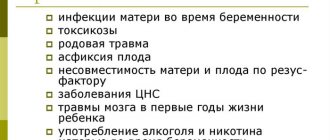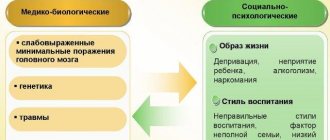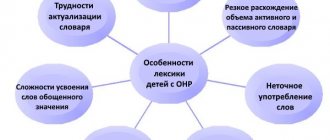Speech disorders have a varied nature depending on the degree of their manifestation, on the localization of the impaired function, on the time period of the pathology, on the presence of secondary disorders formed under the influence of the primary defect.
The modern classification of speech disorders, proposed by leading researchers, is necessary to determine primary and secondary manifestations and is represented in speech therapy science by 2 types of classification: 1) clinical-pedagogical and 2) psychological-pedagogical. When recognizing types of speech defects in typology and grouping, the same phenomena and mechanisms are considered with a different approach. Both developments do not contradict each other, but rather complement each other and show an appropriate approach to the problems of speech therapy disorders and to the selection of optimal means of correctional intervention.
It is important to distinguish speech pathology itself from all kinds of underdevelopment caused by age-related or individual developmental characteristics or insufficiently favorable environmental conditions (speech defects of close relatives, bilingualism in the family, low literacy).
Clinical and pedagogical classification
Goal: clear and detailed description of the types of disorders, taking into account the interstructural interaction of speech defects with their underlying causes, including those of a natal and prenatal nature. It is based on a number of psychological, linguistic, medical, clinical and etiopathogenetic factors that have a complex impact. All types of speech impairments are divided into 2 groups: disorders of oral and written speech (clickable diagram).
A significantly different view on the systematization of childhood deviations was proposed by R. E. Levina. Her works laid the foundation for children's speech therapy, which subsequently became a separate area with its own object of study.
Total PNR
With total speech impairment (TSI), there are deficiencies in all areas of the language: phonology, sound pronunciation, grammar and vocabulary. The child's mastery of all language means is generally impaired.
The disorders presented in the classification are classified as severe:
1. Alalic variant (motor and sensory alalia). With motor alalia, a child under 4-7 years of age does not use speech, except for a set of babbling words (for example, woof-woof, co-co, bi-bi). The child cannot fully communicate, which entails serious impairments in communication capabilities. It is relatively rare - 0.5%.
Sensory alalia is an even more severe condition in which the child does not understand spoken speech and does not connect words with meaning. The disease has been little studied and is difficult to diagnose. Correction not started in time (from 2-3 years of age) can cause serious maladaptation and lead to disability.
2. Paraalalic version of THP. The symptoms and signs are similar to motor alalia, but it proceeds much easier and is overcome more quickly (in 2-3 years).
3. Clinical forms with a complex type of disorder (“mixed”).
If by the end of preschool age it is not possible to cope with dysontogenesis, the child is sent to study at a speech school. To achieve noticeable results, correction work must continue for at least 5-6 years. A regular school can only aggravate the child’s condition: serious difficulties will arise in learning, and a lack of oral speech causes deficiencies in written language.
Comorbidity
Total PND is characterized by a high comorbidity rate. 60-70% of children with sound pronunciation disorders have problems with attention, memory and the emotional sphere. 50% of children with dyslexia and 60-80% of children with mental retardation or mental retardation have oral speech disorders.
Speech impairment is quite often accompanied by many disorders:
1. Cognitive deficit:
- random access memory;
- verbal-logical functions (the ability to think categorically using generalizing concepts);
- successive operations;
- finger and articulatory praxis;
- attention (auditory, rarely visual);
- immaturity of gaming competence.
2. Personal sphere:
- surface of social connections;
- immaturity of the emotional-volitional sphere.
3. Communicative competence:
- poor command of dialogue (especially monologue);
- difficulties in establishing partnerships.
The lack of language means limits the possibility of mastering verbal and logical skills in thinking. This can affect the personal sphere, because difficulties arise in communicating with peers and adults. If the child received timely and comprehensive help, the outcome will be more favorable. Comprehensive care means both the participation of a speech therapist and the participation of doctors.
Dysontogenesis is dangerous with negative consequences. The child has difficulties in learning in basic subjects, there is an inferiority of socio-cultural discourse and behavioral disturbances. It is worth talking separately about dyslexia and dysgraphia, since these are the most serious disorders that follow speech impairment.
Psychological and pedagogical classification
Goal: to determine the most optimal ways to help people with speech pathology. The identified speech therapy disorders are grouped according to the principle from particular to general. The classification is created on the basis of linguistic and psychological factors, which take into account the structural elements of the language system. Such elements include articulatory motor skills, sound pronunciation, lexical and grammatical structure, coherent speech, and non-speech mental functions. The symptoms of the defect are identified in various types of speech underdevelopment in children. As a result, the levels of formation of individual components of the speech language system of the speech reader are determined (the diagram is clickable).
Dysgraphia and dyslexia are not defined as independent defects, since they are included in the structure of FFND and OHP as their secondary consequences. However, in practice, reading and writing defects are often identified as an independent problem. In this case, diagnosis and correction of dysgraphia occurs regardless of anamnestic data.
Thus, one of the tasks of speech therapy is to improve the systematization of speech disorders. The defects discussed above have their own subtypes.
At the beginning of the article there is a classification of speech disorders (table according to O. V. Pravdina).
About speech therapy diagnoses and classifications
Talking about speech therapy classifications and diagnoses is a very popular and sore subject for discussion. It has become fashionable to reject the old and present as an alternative targeted criticism of varying degrees of argumentation. This is where the matter ends, because it is not possible for an ordinary critic to offer something new for a reason, but in the system. Serious attempts to revise the classification of speech disorders, as a rule, remain unattended because they are difficult to understand and require basic interdisciplinary knowledge.
An example is the classification of A.N. Korneva. There have always been questions about conclusions and classifications, but recently “pseudo-classifiers” have become so lively that they have made doubts not only among young specialists, for example:
Having received three letters almost in a row from highly respected and experienced colleagues, I came to the conclusion that it was still worth speaking out. Somehow the tactic stopped working: “I encourage or reinforce what is desirable, I ignore what is undesirable.” According to the tradition that has developed in the group, I don’t name names, but I hope that the colleagues who pushed me to create this very large post will reveal themselves and help develop the topic in the comments.
Here they are, our catalyst conversations.
Conversation 1. Colleague (candidate of pedagogical sciences, associate professor, specialist with extensive practical experience).
Question. Olga Vyacheslavovna, hello. Sorry for God's sake, I can't understand, maybe I stopped understanding something. Do you remember how long ago alalia was reduced to dyspraxia-apraxia and ceased to be related to language disorders? I'm at a loss.
O.E. …, Good evening! Do not worry. Apparently, this lady is haunted by the laurels of her widely known and deservedly respected colleagues in the Internet space. These actions (criticism of classifications) are indirectly related to speech therapy. The plan for writing posts to create hype is simple: scold your colleagues for being stupid and unprofessional; run into parents; declare all classifications obsolete (at the same time, offer nothing new or offer secret knowledge to a select few for a lot of money, but it should be in publicly available publications and reports); inform the world that alalia cannot be diagnosed without MRI and EEG, then generally question its existence; then start a noisy war with those who disagree. Usually it ends quite quickly. The character reduces the activities on his page to a formal minimum, switching to home-grown psychotherapy/litigation/theatrical activities. A typical scheme for “promotion” of stars from speech therapy with a demonstrative type of behavior.
Conversation 2. Colleague (successful, very adequate blogger on Instagram, my master’s student, practicing speech therapist).
Colleague. Olga Vyacheslavovna, good afternoon! I'm back with my Instagram;) I wrote today about how to write a speech therapy report. Of course, in the comments there is a market, the level of education and culture is still low in the Instagram environment, so, maybe you can tell me how and who writes a conclusion to children after a CI? And based on what classification.
O.E. …, Good afternoon! For children with CIs, the conclusion is written by the person they came to see. If you come to a speech therapist, and the speech therapist will write) But it will be a systemic underdevelopment of speech - according to the psychological and pedagogical classification, it is not diagnosed. I would limit myself to the diagnosis, in the descriptive part I would give a description of speech and non-speech processes in sections, transfer information from the medical documentation about the state of hearing there, and note that a CI was performed. In the absence of a doctor’s certificate, I noted that it was written down from the parents’ words. That. it would be clear to anyone reading what was wrong with the child, but the diagnosis would also be within the scope of our speech therapy competence. And who else can write how, what and on what basis - I don’t know. I guess. what the doctor will write based on ICD-10. The PMPK will focus on ensuring that the conclusion is consistent with the version of the standard (FSES OVZ).
Colleague. Do you know what they write about onr (2 level rr), motor alalia, erased dysarthria?? Now I’ll show you, it’s just bleeding from the eyes! And right now... a girl... is teaching 500 PEOPLE that our classification is not correct, and we need to write like this (see photo 3). I won’t give up, I really decided to fight, the scale of this nonsense is simply incredible! They are already teaching this. So, please tell me about Lalaeva’s article, if you know, it is very well written, but you need to know that this is definitely Lalaeva’s article, forgive me for interrupting you, but while I am reacting very sharply to all this, they endlessly call our scientists names and works with old stuff and rubbish. And just so confidently, loudly...
Dyspraxia writes (a blogger on Instagram. not R.I. Lalaeva. approx. O.E.) that no one among speech therapists described it before her post on Instagram, only psychologists described it!!! And 300 people: yes! ..., teach us what articulatory dyspraxia is!! And it’s so difficult for them to read Kornev, it’s a whole 350 pages!!!!
O.E. ..., calm down! This is all for self-promotion, so that you fall for it. DO NOT react! Otherwise, all your subscribers will know about their existence. This scheme is as old as time. Only the lazy did not go through the classification. The fuse won't last long. All this has already happened. These are pathetic imitators hungry for fame. There is no need to help them.
This is definitely an article by R.I. Lalaeva. I definitely won’t reproduce the source, but A.A. and I. Tarakanova in “Differential Diagnostics...” and with colleagues in “Monitoring...” we refer to and quote her.
Conversation 3. Colleague (founder and director of a successful speech therapy center, author of manuals, practicing speech therapist with extensive experience)
Question. Olga, hello! Please tell me if there are any samples of wording for the correct execution of conclusions, calibrated charts of examinations, diagnostics and conclusions. If now everyone criticizes the three letters OHP, then is there any alternative for specialists? The disability will also go away by the fall, and there will be changes in diagnostics. Now where can speech therapists find up-to-date information? Thank you in advance.
O.E. …, Good afternoon! Anyone who criticizes three letters is doing cheap PR for himself specifically in order to organize activity around his group page. There are three main topics for this: “the diagnoses are bad, the classifications are outdated, but I know how to do it, come to me, I’ll tell you,” “alalia-dysarthria cannot be diagnosed without a doctor and MRI and EEG, come to us, we We’ll explain everything exactly, and everyone else is a charlatan”, “the parents are bad, if only they were removed and we would - wow!!!”, “all my colleagues are fools, only I’m d’Artagnan.” The answer about diagnoses is simple. Yes, classifications are not perfect, but classifications cannot be perfect at all. The more criteria they take into account, the more difficult it is to use them for practical purposes. I think that it is premature to plan a revolution in writing diagnoses and conclusions. Such problems should be worked on by laboratories (departments), and not by individual individuals. I also don’t see any point in standardizing cards and diagnostic schemes yet. In my work I adhere to the traditional logic described by R.I. Lalaeva.
For children with primary speech disorders: the first part is a symptomatic diagnosis, according to the psychological and pedagogical classification, the second - according to the clinical and pedagogical classification, for example: OHP: motor alalia, or FFD: pseudobulbar dysarthria. For middle school students, teenagers, adults - only the second classification. For secondary violations: SNR.
I write in detail about the speech therapy diagnosis in the manual Eletskaya O.V., Loginova E.A., Shchukina D.A. and others. Monitoring of correctional and speech therapy work. — M.: Forum, 2015. I attach photos of the pages.
I expressed my opinion about the current system of typology of speech disorders in our country back in 2012. in the collection of the conference dedicated to the memory of R.I. Lalaeva. Let me quote the text in full.
On the issue of typology of speech development disorders Speech therapists, psychologists, linguists, and doctors of various specialties are involved in the study and correction of speech pathology. At the same time, each participant in the process considers the problem from his own point of view and uses classifications accepted in their field of knowledge to describe speech disorders.
In domestic speech therapy practice, it is traditional to use clinical-pedagogical and psychological-pedagogical classifications of speech disorders. These classifications, although they consider the same phenomena from different points of view, do not contradict, but complement one another and are focused on solving different problems of a single, but multifaceted process of correction of speech development disorders. Both classifications refer to primary speech underdevelopment in children.
In foreign literature and in ICD-10, speech and school skills disorders are designated as specific developmental disorders, i.e. by and large, dysontogenetic disorders. The term “specific” speech disorders is used along with the term “primary”. This emphasizes the presence of a major clinical defect primarily in the area of speech and language development (McLeod S, Harrison L., 2009; Evans J.; 2009; Robinson R., 1999). However, recent studies demonstrate frequent concomitant disorders of nonverbal intelligence, fine motor skills, and the emotional-volitional sphere in children with primary speech disorders, which casts doubt on the term “specific” speech disorders (Robinson R., 1999; Gromova O.E., 2004; Levina R.E., 1975; Semago N.Ya., Semago M.M., 2005; Stepanenko D.G., 2003). Secondary speech disorders arise and are considered in the structure of the underlying disease, which may be hearing impairment, mental retardation, other mental and neurological disorders, congenital or acquired defects of the maxillofacial area, severe somatic diseases (Stepanenko D.G., Sagutdinova E.Sh. , 2010).
The clinical and pedagogical classification is based on the traditional collaboration between speech therapy and medicine, but unlike the clinical one, the types of speech disorders identified in it are not strictly tied to the forms of the disease.
One of the first attempts to classify speech disorders from these positions was made by the German therapist Adolf Kussmaul in 1877. He streamlined the terminology and systematized previously established ideas about the types of speech disorders. Subsequently, adjustments to the classification were made by M.E. Khvattsev, F.A. Rau, O.A. Pravdina, S.S. Lyapidevsky, as a result of which the content characteristics of speech disorders were significantly expanded and the fragmentation of descriptions of speech pathologies was eliminated.
This classification is focused on the correction of speech defects, the development of a differentiated approach to overcoming them and on detailing the types and forms of speech disorders. This classification takes into account the intersystem interactions of speech disorders with the material substrate, primarily the anatomical and physiological mechanism of the speech disorder, which makes it possible to reveal the disorder as a whole and determine in which cases only speech therapy intervention is necessary, and in which complex medical and pedagogical intervention is necessary.
In the clinical and pedagogical classification, the leading role is given to psychological and linguistic criteria, which make it possible to distinguish one speech disorder from another:
- violations of the form of speech (oral or written);
- violations of the type of speech activity in relation to each of the forms (for oral - speaking or listening, for written - reading or writing);
- violation of the stage (link) of speech generation or perception (internal or external formulation of an utterance, sensory or receptive stage);
- violations of operations that carry out the formalization of an utterance at one or another stage of the generation or perception of speech;
- violation of the means of forming an utterance (distinction between linguistic and pronunciation units) (Pyatnitsa T.V., 2010).
R.E. Levina developed a psychological and pedagogical classification of speech disorders. The basis for this was the separation of children's speech therapy into a separate section of speech therapy science, as well as the formulation of new principles for the analysis of speech disorders in children.
The psychological and pedagogical classification is built taking into account linguistic and psychological criteria, among which are:
- components of the speech system (sound aspect of speech, grammatical structure, vocabulary);
- functions of speech (communicative and logical);
- the relationship between oral and written speech.
The psychological and pedagogical classification of speech disorders is aimed at:
- to develop methods of pedagogical influence for working with a group of children;
- identification of general manifestations of the defect in various forms of abnormal speech development in children, determination of their particular manifestations and construction of a correction process on their basis.
Speech disorders in this classification are divided into two groups.
1st group. Violation of means of communication (phonetic-phonemic underdevelopment and general underdevelopment of speech).
Phonetic-phonemic underdevelopment of speech is a violation of the processes of formation of the pronunciation system of the native language in children with various speech disorders due to defects in the perception and pronunciation of phonemes.
The following main manifestations of this condition are identified (Filicheva T.B. et al., 1989).




